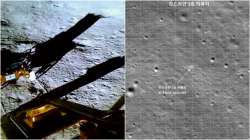South Korea's Danuri spots India's Vikram Lander on Moon's Shiv Shakti point
Danuri is equipped with a variety of instruments, including a high-resolution camera, a spectrometer, and a magnetometer.

South Korea's lunar orbiter, Danuri, captured the Indian lander Vikram on the Moon's Shiv Shakti point. The successful capture is a major milestone for the South Korean space program and a significant step towards the country's goal of becoming a major player in lunar exploration. Danuri was launched in August 2022 and entered lunar orbit in October 2022. The spacecraft is equipped with a variety of instruments, including a high-resolution camera, a spectrometer, and a magnetometer. It is also carrying a small rover, which is scheduled to be deployed on the Moon in the coming months.
The capture of Vikram is a major coup for Danuri. The lander was lost during its descent to the Moon in September 2019. However, South Korean scientists were able to track down the lander and identify its location. Danuri was then able to use its cameras and instruments to capture images of the lander and its surroundings.
The successful capture of Vikram is a major boost for the South Korean space program. It demonstrates the country's capabilities in lunar exploration and paves the way for future missions to the Moon. South Korea is now one of a handful of countries that have successfully captured a spacecraft on the Moon.
The capture of Vikram is also a significant step towards the country's goal of becoming a major player in lunar exploration. South Korea is planning to send a robotic rover to the Moon in 2024 and a human crew in 2030. The successful capture of Vikram is a major milestone on this journey.
India's Chandrayaan-3 Mission
In a significant achievement, India's Chandrayaan-3 mission has successfully landed on the lunar surface, marking the nation's third triumphant lunar mission. The touchdown took place on August 23 at a designated landing site known as 'Shiv Shakti Point,' situated approximately 600 kilometers from the Moon's South Pole.
Since its momentous landing, the Chandrayaan-3 rover has embarked on an ambitious scientific journey, conducting comprehensive research and data collection endeavors. Its primary mission objective revolves around the meticulous analysis of the moon's soil composition and atmospheric characteristics.
The Chandrayaan-3 mission commenced its journey on July 14, with a liftoff from the Satish Dhawan Space Centre in Sriharikota, Andhra Pradesh. After a successful journey, the spacecraft entered lunar orbit on August 5, and later, on August 17, the lander module successfully separated from the propulsion module, paving the way for its historic lunar descent. This mission signifies India's continued dedication to exploring and advancing our understanding of the lunar environment.
Also read | Centre announces winners of Shanti Swarup Bhatnagar Prizes 2022 after a year's delay | Check list
Also read | Aditya-L1 successfully completes third earth-bound manoeuvre, says ISRO

